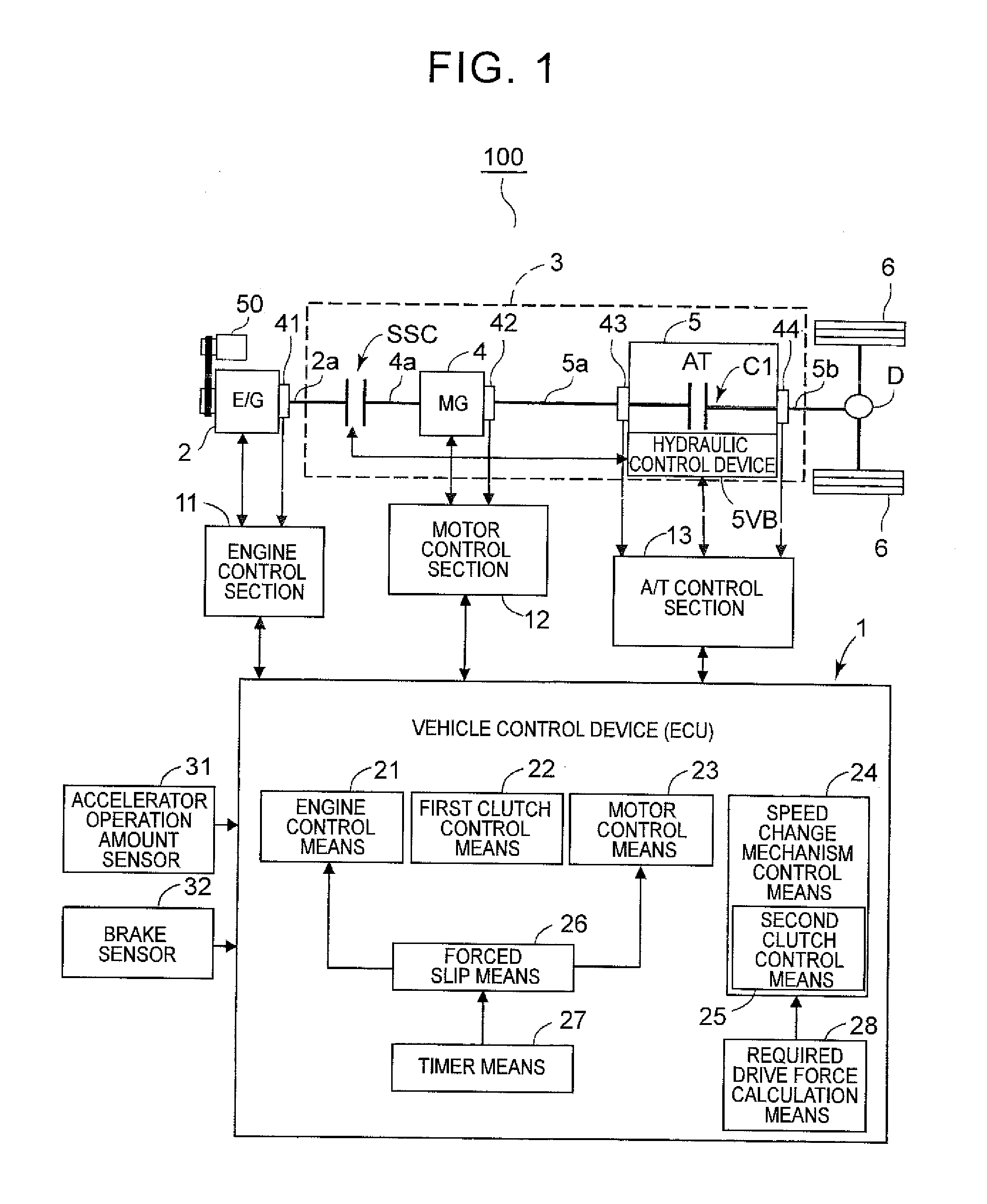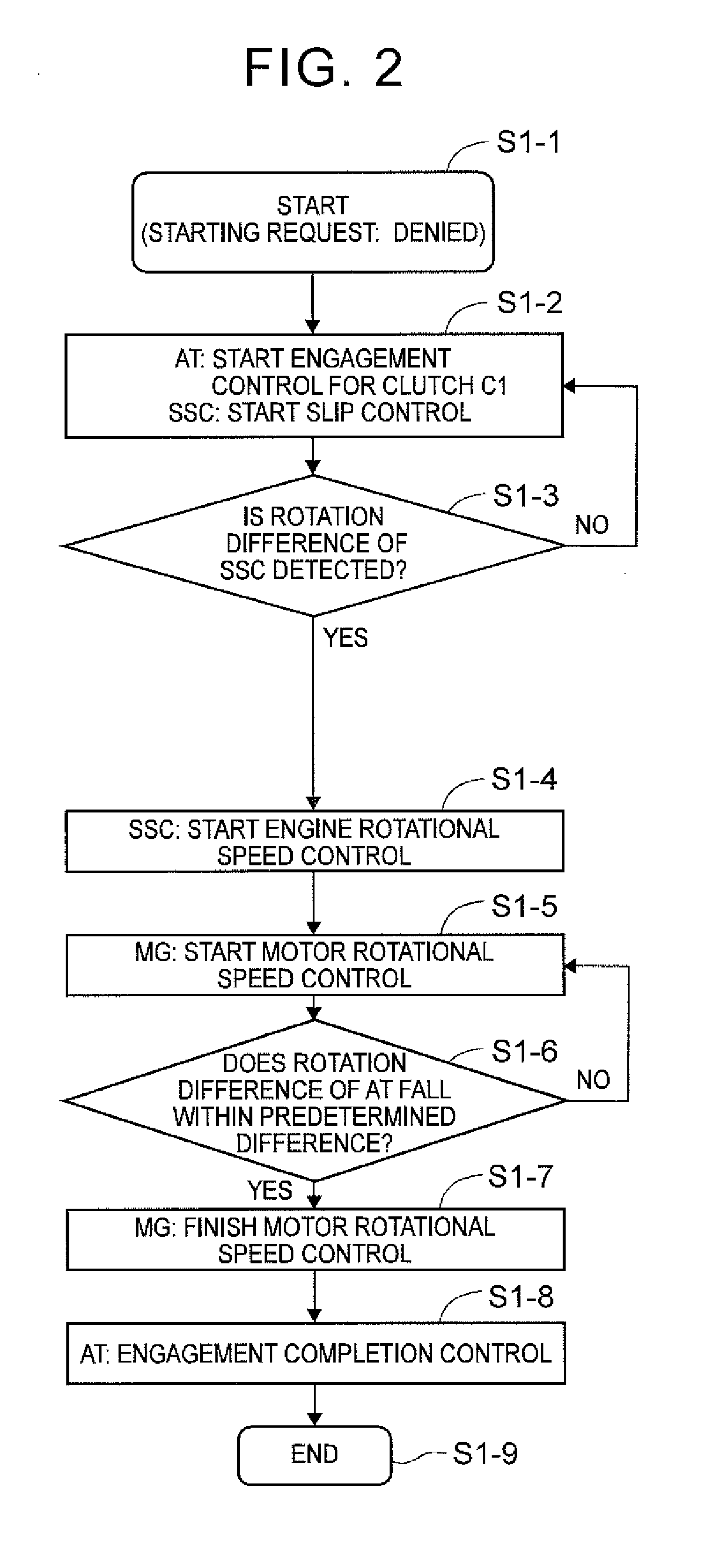Control device for hybrid vehicle
a control device and hybrid technology, applied in the direction of machines/engines, process and machine control, instruments, etc., can solve the problems of inability to start the vehicle through ev travel, high cost, and driver's hesitation, so as to secure the controllability of the slip engagement state of the second clutch, reduce the revolving speed of the rotary electric machine, and reduce the load
- Summary
- Abstract
- Description
- Claims
- Application Information
AI Technical Summary
Benefits of technology
Problems solved by technology
Method used
Image
Examples
first embodiment
[0069]A first embodiment will be described below with reference to FIGS. 1 to 4. Forced slip means 26 and timer means 27 in FIG. 1 are provided for a second embodiment, and will not be described in relation to the first embodiment. Herein, the terms “rotational speed” and “revolving speed” are used as synonyms.
[0070]As illustrated in FIG. 1, a hybrid vehicle 100 includes, as its drive system, an engine 2 and a hybrid drive device 3 connected to an output shaft (crankshaft) 2a of the engine 2. An output shaft 5b of the hybrid drive device 3 is drivably coupled to a differential device D via a propeller shaft or the like. A drive force is transferred from the differential device D to left and right wheels 6 via left and right drive shafts or the like. In the hybrid vehicle 100, in addition, an alternator 50 capable of generating power through rotation of the engine 2 to supply electric power to an accessory (such as lamps and an air conditioner) is disposed to be drivably coupled to t...
second embodiment
[0122]Next, a second embodiment obtained by partially modifying the first embodiment will be described with reference to FIGS. 5 to 7. Portions of the hybrid vehicle 100 and the control device 1 that are the same as those of the first embodiment will not be described. In the following description, in addition, a case where the motor rotational speed Nm is reduced for forced slip control will first be described with reference to FIGS. 5 and 6, and a case where the engine rotational speed Ne is increased for the forced slip control will next be described with reference to FIG. 7 mainly with focus on differences from FIG. 6.
[0123]In the second embodiment, as illustrated in FIG. 1, the vehicle control device 1 includes the forced slip means 26 for forcibly causing the first clutch SSC to slip, and the timer means 27 for counting the time elapsed from the detection of a starting request (suspension of power generation control).
[0124]Next, control performed when the vehicle starts in the ...
third embodiment
[0158]Next, a third embodiment obtained by partially modifying the first embodiment will be described with reference to FIGS. 8 and 9. Portions of the hybrid vehicle 100 and the control device 1 that are the same as those of the first embodiment will not be described.
[0159]When the third embodiment is compared with the first embodiment, step S3-8 and step S3-9 are added as illustrated in FIG. 8, and slip that occurs when torque that is larger than the torque capacity of the second clutch C1 is transferred to the second clutch C1 is prevented for a predetermined time (first predetermined time) TB (that is, until the torque capacity of the second clutch C1 is sufficiently increased) from time t14 when a transition is made from the rotational speed control for the motor 4 to the torque control as illustrated in FIG. 9. Step S3-1 to step S3-7 illustrated in FIG. 8 correspond to step S1-1 to step S1-7, respectively, illustrated in FIG. 2. Step S3-10 and step S3-11 illustrated in FIG. 8 c...
PUM
 Login to View More
Login to View More Abstract
Description
Claims
Application Information
 Login to View More
Login to View More - R&D
- Intellectual Property
- Life Sciences
- Materials
- Tech Scout
- Unparalleled Data Quality
- Higher Quality Content
- 60% Fewer Hallucinations
Browse by: Latest US Patents, China's latest patents, Technical Efficacy Thesaurus, Application Domain, Technology Topic, Popular Technical Reports.
© 2025 PatSnap. All rights reserved.Legal|Privacy policy|Modern Slavery Act Transparency Statement|Sitemap|About US| Contact US: help@patsnap.com



